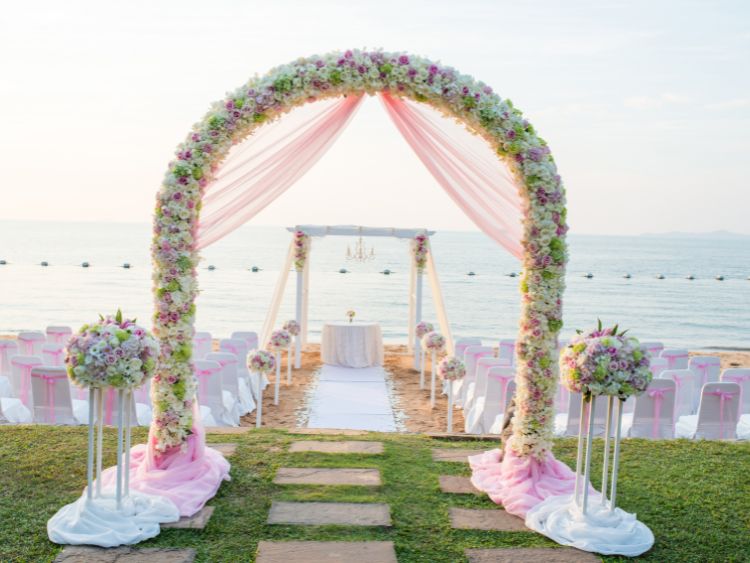Why Dress Codes Matter at Weddings
When it comes to weddings, figuring out what to wear can sometimes be just as tricky as picking out the perfect gift. Every invitation is a hint to the kind of vibe the couple is setting for their big day, and understanding wedding dress codes ensures you’re not only dressed appropriately but that you also contribute to the special atmosphere they’ve planned. This guide will help you decode wedding dress codes so you can confidently pick your attire and focus on what really matters—celebrating the love!
Common Wedding Dress Codes and What They Mean
Navigating wedding dress codes doesn’t have to be a head-scratcher. Here’s a breakdown of the most popular dress codes you’ll find on wedding invitations, along with examples to help you nail the look.
1. Black Tie
- Definition: The epitome of formal. Black-tie dress codes typically mean elegance and sophistication.
- What to Wear:
- For Men: A classic tuxedo, black bow tie, polished black shoes, and optional cufflinks.
- For Women: A formal evening gown or a sophisticated cocktail dress in dark or neutral colors.
- Tips: Avoid bright colors or overly casual accessories; black tie means polished and classic.
2. White Tie
- Definition: The most formal dress code of them all—think royal events or grand galas.
- What to Wear:
- For Men: Tailcoat, white bow tie, polished dress shoes, and possibly gloves.
- For Women: A full-length ball gown, often accompanied by elegant gloves.
- Tips: White tie events are rare, so go all out if you’re lucky enough to be invited to one!
3. Formal or Black Tie Optional
- Definition: A step below black tie, but still fairly dressy.
- What to Wear:
- For Men: A dark suit and tie, though a tuxedo is optional.
- For Women: A long dress, evening dress, or a chic cocktail dress.
- Tips: If in doubt, it’s always better to dress slightly up rather than too casual.
4. Cocktail Attire
- Definition: Fancy but with a bit more freedom. Cocktail attire strikes a balance between formal and casual.
- What to Wear:
- For Men: A suit and tie, usually in darker colors for evening events.
- For Women: A stylish cocktail dress or even a jumpsuit with elegant accessories.
- Tips: Have fun with accessories or a pop of color, but avoid anything too flashy.
5. Semi-Formal or Dressy Casual
- Definition: A relaxed yet polished look. Suitable for most indoor weddings or daytime events.
- What to Wear:
- For Men: Dress slacks with a button-down shirt, tie optional, and a blazer.
- For Women: A midi or knee-length dress, or a stylish skirt and top combo.
- Tips: Choose breathable fabrics, especially for outdoor weddings, and opt for softer colors for daytime events.
6. Beach Formal
- Definition: Classy yet practical, suitable for sand and sun.
- What to Wear:
- For Men: Light-colored suit, preferably linen, with or without a tie.
- For Women: A flowy dress or chic sundress, and sandals if the venue allows.
- Tips: Keep your colors light and your fabrics breezy.
7. Casual or Daytime Attire
- Definition: Perfect for laid-back celebrations, like backyard weddings.
- What to Wear:
- For Men: Khakis or dress pants with a button-down shirt.
- For Women: A casual dress, skirt, or nice blouse with dress pants.
- Tips: Keep it simple and avoid overly bright or flashy outfits, as these can stand out too much in a casual setting.
Additional Tips for Choosing the Right Wedding Attire
- Color Matters: Avoid white, as it’s traditionally reserved for the bride. Be mindful of the couple’s culture, as certain colors may have specific meanings.
- Check for Themes: Sometimes, the couple might hint at a theme or color scheme, which can help guide your outfit choice.
- Location and Weather: Think about the setting and season. A dress for a summer garden wedding won’t suit a winter ballroom affair.
FAQs About Wedding Dress Codes
Q: Can I wear black to a wedding?
Yes! Nowadays, wearing black is perfectly acceptable for most wedding dress codes, except maybe casual. It’s considered elegant, and for evening events, it’s always a classy choice.
Q: Is it okay to ask the couple about the dress code if I’m unsure?
Absolutely! It’s always better to ask for clarification than to risk being under or overdressed. Most couples would rather help than have guests feel uncomfortable.
Q: What’s the difference between cocktail attire and semi-formal?
Cocktail attire tends to be a little dressier than semi-formal, especially for evening weddings. Cocktail attire leans more toward chic and trendy, while semi-formal is polished but slightly more laid-back.
Q: Are dress codes really necessary?
While some may see dress codes as limiting, they actually help create a cohesive look for the event. Dress codes ensure that guests complement the setting and contribute to the overall vibe the couple envisions.
Summary: Nail Your Look with Confidence
In the world of weddings, dress codes aren’t just suggestions—they’re keys to unlocking the event’s tone and style. From black tie to beach formal, understanding these guidelines will ensure you show up looking sharp and feeling confident. The right attire makes all the difference, so take a moment to understand what each dress code entails, plan your outfit accordingly, and get ready to celebrate in style!
